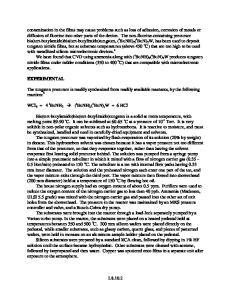Volatile Liquid Precursors for the Chemical Vapor Deposition (CVD) of Thin Films Containing Tungsten
- PDF / 130,085 Bytes
- 6 Pages / 612 x 792 pts (letter) Page_size
- 91 Downloads / 347 Views
VOLATILE LIQUID PRECURSORS FOR THE CHEMICAL VAPOR DEPOSITION (CVD) OF THIN FILMS CONTAINING TUNGSTEN Roy G. Gordon, Seán Barry, Randy N. R. Broomhall-Dillard, Valerie A. Wagner and Ying Wang Department of Chemistry and Chemical Biology, Harvard University, Cambridge, MA 02138
ABSTRACT A new CVD process is described for depositing conformal layers containing tungsten, tungsten nitride or tungsten oxide. A film of tungsten metal is deposited by vaporizing liquid tungsten(0) pentacarbonyl 1-methylbutylisonitrile and passing the vapors over a surface heated to 400 to 500 oC. This process can be used to form gate electrodes compatible with ultrathin dielectric layers. Tungsten nitride films are deposited by combining ammonia gas with this tungsten-containing vapor and using substrates at temperatures of 250 to 400 oC. Tungsten nitride can act as a barrier to diffusion of copper in microelectronic circuits. Tungsten oxide films are deposited by adding oxygen gas to the tungsten-containing vapor and using substrates at temperatures of 200 to 300 oC. These tungsten oxide films can be used as part of electrochromic windows, mirrors or displays. Physical properties of several related liquid tungsten compounds are described. These low-viscosity liquids are stable to air and water. These new compounds have a number of advantages over tungsten-containing CVD precursors used previously. INTRODUCTION Chemical vapor deposition (CVD) is a widely-used process for forming solid materials, such as coatings, from reactants in the vapor phase. CVD processes can have many advantages: good step coverage, dense films, high deposition rates, scalability to larger areas and low cost. CVD of tungsten is usually carried out using tungsten hexafluoride, WF6, as the tungsten source.1 However, the byproduct hydrogen fluoride is highly corrosive and can damage substrates. Residual fluoride contamination in the films can cause problems such as loss of adhesion, or diffusion of fluorine into gate oxides causing threshold voltage shifts.2 Tungsten hexacarbonyl, W(CO)6, is another source for CVD which can avoid the problems with fluorine.3 Gate electrodes of tungsten have been formed by CVD from W(CO)6 on ultrathin dielectrics needed for high speed/high density MOS and CMOS devices.4 W(CO)6 has also been used to deposit tungsten nitride, W2N, with properties suitable for barriers to diffusion of copper in microelectronics.5 CVD using both W(CO)6 vapor and oxygen gas, O2, has produced electrochromic films of tungsten oxide.6 However, tungsten hexacarbonyl does have some practical disadvantages. Sublimation from solid W(CO)6 is not a reproducible source of vapor, since the surface area of a solid changes as the solid evaporates. W(CO)6 is highly toxic and has sufficient vapor pressure at room temperature that toxic concentrations of vapor can be emitted from any spilled material. Also, the carbon monoxide byproduct from its CVD reactions is highly toxic and lacks any warning odor. We have synthesized some new tungsten compounds that overcome the disadvan
Data Loading...











